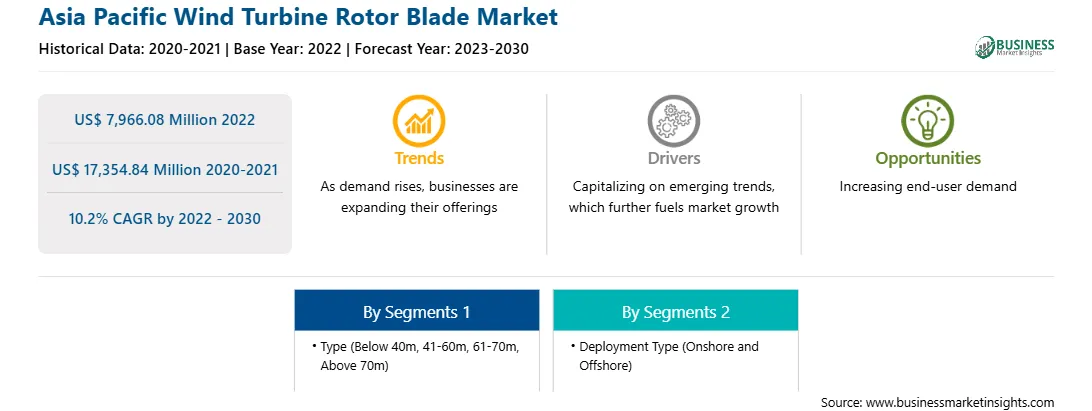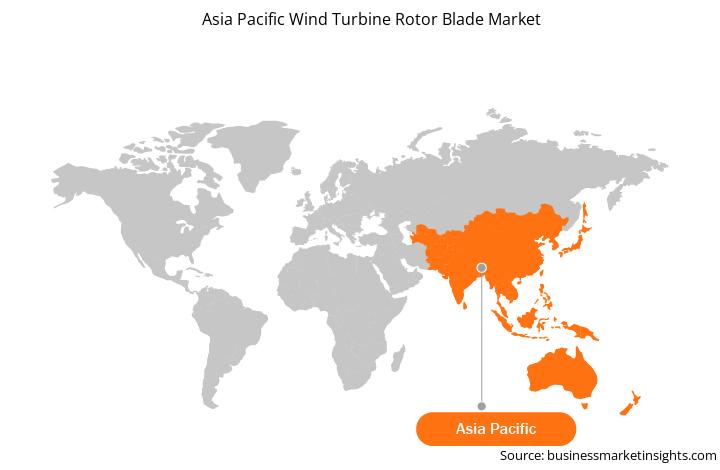The Asia Pacific wind turbine rotor blade market was valued at US$ 7,966.08 million in 2022 and is expected to reach US$ 17,354.84 million by 2030; it is estimated to grow at a CAGR of 10.2% from 2022 to 2030.
Offshore wind farms are thought to be more efficient than onshore wind farms due to higher wind speeds, greater consistency, and a lack of physical interference from land or man-made things. Offshore wind speeds are typically higher than on land. Small changes in wind speed result in substantial gains in energy production: a turbine operating in a 15-mph wind can produce twice as much energy as a turbine operating in a 12-mph wind. Faster offshore wind speeds mean that significantly more energy can be generated. Offshore wind speeds are more consistent than on land. A more consistent supply of wind means a more dependable source of energy. Thus, owing to higher efficiency compared to onshore wind farms, the investments in offshore farms are increasing.
In Asia Pacific, the growing governmental focus on promoting renewable energy is fueling the number of wind projects. Pinnapuram Integrated Renewable Energy Project, Yudean Yangjiang Qingzhou I Offshore Wind Farm, MacIntyre Wind Farm, Yuedean Yangjiang Qingzhou II Offshore Wind Farm, and Abukuma Onshore Wind Farm were a few major wind projects in Asia Pacific in 2022. Further, India has also set an ambitious goal of constructing 30 gigatons (GW) of offshore wind capacity by 2030. Additionally, in 2022, the Asian Development Bank sealed a US$ 107 million financing project with BIM Wind Power Joint Stock Company to help the operation of an 88 MW wind farm in Ninh Thuan province, Vietnam. Also, in Japan, the government has set the target of 10 GW of offshore wind installation by 2030.
Such investments are expected to fuel the demand for offshore wind farms in the future, ultimately generating lucrative opportunities for the wind turbine blades industry.
The Asia-Pacific wind turbine rotor blade market is classified into China, India, Japan, Australia, South Korea, and the Rest of Asia Pacific. Asia Pacific is one of the leading regions in the wind turbine rotor blade market due to minimized cost of wind energy, favorable government initiatives, and a rise in investment in wind energy projects. The wind turbine rotor blade market expansion in Asia Pacific is primarily attributed to increasing investment in the renewable industry, exponential increase in industrialization and urbanization, wind energy generation capacity, new electrification projects, and grid strengthening initiatives.
According to the Global Wind Energy Council, newly added wind capacity in Asia Pacific in 2022 accounted for 56% of total wind capacity additions globally, with China contributing 87% of total additions in Asia Pacific. The wind energy sector in Asia Pacific is set for rapid expansion. It could make up nearly a quarter of the power capacity mix in the area this decade, according to a new study, as high domestic demand for offshore wind power turns Mainland China into the world's largest market by 2030. Thus, the rapid expansion of wind energy installations in the region is anticipated to propel the demand for wind turbine rotor blades from 2022 to 2030.
Strategic insights for the Asia Pacific Wind Turbine Rotor Blade provides data-driven analysis of the industry landscape, including current trends, key players, and regional nuances. These insights offer actionable recommendations, enabling readers to differentiate themselves from competitors by identifying untapped segments or developing unique value propositions. Leveraging data analytics, these insights help industry players anticipate the market shifts, whether investors, manufacturers, or other stakeholders. A future-oriented perspective is essential, helping stakeholders anticipate market shifts and position themselves for long-term success in this dynamic region. Ultimately, effective strategic insights empower readers to make informed decisions that drive profitability and achieve their business objectives within the market. The geographic scope of the Asia Pacific Wind Turbine Rotor Blade refers to the specific areas in which a business operates and competes. Understanding local distinctions, such as diverse consumer preferences (e.g., demand for specific plug types or battery backup durations), varying economic conditions, and regulatory environments, is crucial for tailoring strategies to specific markets. Businesses can expand their reach by identifying underserved areas or adapting their offerings to meet local demands. A clear market focus allows for more effective resource allocation, targeted marketing campaigns, and better positioning against local competitors, ultimately driving growth in those targeted areas.Asia Pacific Wind Turbine Rotor Blade Strategic Insights

Asia Pacific Wind Turbine Rotor Blade Report Scope
Report Attribute
Details
Market size in 2022
US$ 7,966.08 Million
Market Size by 2030
US$ 17,354.84 Million
Global CAGR (2022 - 2030)
10.2%
Historical Data
2020-2021
Forecast period
2023-2030
Segments Covered
By Type
By Deployment Type
Regions and Countries Covered
Asia-Pacific
Market leaders and key company profiles
Asia Pacific Wind Turbine Rotor Blade Regional Insights

The Asia Pacific wind turbine rotor blade market is segmented based on type, deployment type, and country. Based on type, the Asia Pacific wind turbine rotor blade market is segmented into Below 40m, 41-60m, 61-70m, and Above 70m. The Above 70m segment held the largest market share in 2022.
In terms of deployment type, the Asia Pacific wind turbine rotor blade market is bifurcated into onshore and offshore. The onshore held a larger market share in 2022.
Based on country, the Asia Pacific wind turbine rotor blade market is segmented into Australia, China, India, Japan, South Korea and the Rest of Asia Pacific. China dominated the Asia Pacific wind turbine rotor blade market share in 2022.
TPI Composites Inc, Vestas Wind Systems AS, ENERCON GmbH, LM Wind Power AS, Siemens Gamesa Renewable Energy SA, Acciona SA, Suzlon Energy Ltd, Nordex SE, Envision Energy USA Ltd, and Lianyungang Zhongfu Lianzhong Composites Group Co Ltd are some of the leading companies operating in the Asia Pacific wind turbine rotor blade market.
1. TPI Composites Inc
2. Vestas Wind Systems AS
3. ENERCON GmbH
4. LM Wind Power AS
5. Siemens Gamesa Renewable Energy SA
6. Acciona SA
7. Suzlon Energy Ltd
8. Nordex SE
9. Envision Energy USA Ltd
10. Lianyungang Zhongfu Lianzhong Composites Group Co Ltd.
The Asia Pacific Wind Turbine Rotor Blade Market is valued at US$ 7,966.08 Million in 2022, it is projected to reach US$ 17,354.84 Million by 2030.
As per our report Asia Pacific Wind Turbine Rotor Blade Market, the market size is valued at US$ 7,966.08 Million in 2022, projecting it to reach US$ 17,354.84 Million by 2030. This translates to a CAGR of approximately 10.2% during the forecast period.
The Asia Pacific Wind Turbine Rotor Blade Market report typically cover these key segments-
The historic period, base year, and forecast period can vary slightly depending on the specific market research report. However, for the Asia Pacific Wind Turbine Rotor Blade Market report:
The Asia Pacific Wind Turbine Rotor Blade Market is populated by several key players, each contributing to its growth and innovation. Some of the major players include:
The Asia Pacific Wind Turbine Rotor Blade Market report is valuable for diverse stakeholders, including:
Essentially, anyone involved in or considering involvement in the Asia Pacific Wind Turbine Rotor Blade Market value chain can benefit from the information contained in a comprehensive market report.